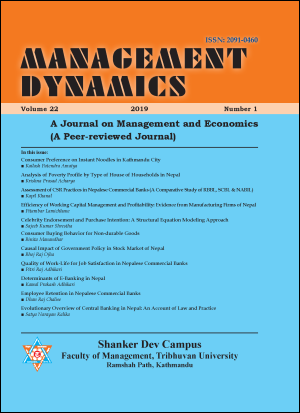Infrastructure Development and Economic Growth in Nepal
DOI:
https://doi.org/10.3126/md.v23i2.35817Keywords:
gross domestic product, infrastructures, human capital, unit root, cointegration, error correction termAbstract
This article, on infrastructure development and economic growth in Nepal, focuses on the infrastructure development that seems to affect economic growth in Nepal during the study period 1994-2018. To investigate the casual relationship between infrastructure development and the economic growth, this study has employed Engel-Granger cointegration test and Error Correction Mechanism (ECM) model. The results showed a cointegration and a stable relationship between gross domestic product and infrastructure variables—such as total length of road, percentage of economically active population, percentage of tertiary education enrollment, and gross capital formation. In addition, the coefficient of Error Correction term was -0.88—signifying about 88 percent adjustments towards equilibrium, confirmed by the occurrence of a stable long-run relationship among the variables. The sign of Error correction term (Ect) became negative and statistically significant at the 1 percent level, indicating the possibility of convergence towards equilibrium in each period with adjustment captured by difference terms. This study has its implication for policymakers to raise economic growth through infrastructure development. The expansion of infrastructure network leads to the enhancement of efficiency and competitive market, and the acceleration of the economic growth within the country.
Downloads
Downloads
Published
How to Cite
Issue
Section
License
Copyright © Research Management Cell, Shanker Dev Campus

